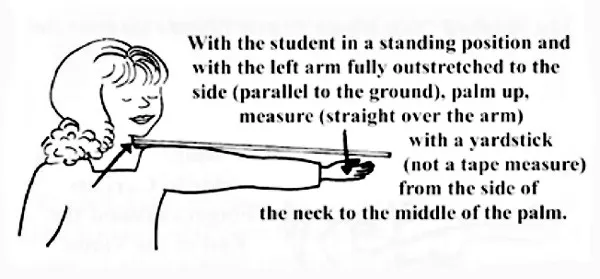Stringed Instrument Sizing
Selecting an appropriately sized violin, viola, cello, or bass prevents fatigue, chronic pain, and long-term injury. An orchestral musician playing with an improperly sized instrument may find learning too hard and may give up too soon. Expect a young musician to move up two or three instrument sizes as they grow. Therefore, renting or borrowing an instrument for the first few years may reduce associated financial costs and allow funds to be saved for the purchase of a step-up or collegiate-grade instrument when the student is older. Orchestral stringed instruments are represented in size by a fraction (which looks like a time signature to musicians). A full-sized instrument for a nearly grown person is represented by the fraction 4/4; think of it like a whole pizza pie. Smaller, less than full-sized instruments are defined as fractional amounts of the whole, such as 3/4, 1/2, and so on. So, grab a taut tape measure or yardstick, and let's go sizing! When in doubt, ask our directors for guidance.
Violin
In this chart (click to zoom), measure the distance between the base of the musician's neck to the end of their left wrist. If the student falls between sizes, choose the smaller size. If a violin is available, place it under their chin as if playing. Extend the arm fully and cup the hand around the scroll. If their fingers wrap all the way around the scroll, then this size will work well.
Viola
Violas are bigger than violins. Sometimes, violins are strung like violas to make smaller sized violas suitable for students. Violas are an exception to the use of fractions to express size. A viola's size is taken by measuring the long distance across the instrument's back. In the chart below (click to zoom), measure the distance from the musician's neck to the middle of their left palm. If the student falls between sizes, selecting the smaller size is best. While holding the viola under their chin, the player's fingers should be able to wrap all the way around the scroll.
Cello
Using the chart below (click to zoom), measure the distance between the base of the student's neck to the middle of their palm when the left arm is fully extended out, parallel to the floor. If the student falls between sizes, pick the smaller size.
Bass
Even the mighty, upright, double-basses come in more accessible sizes! NHME has a massive 3/4 bass and a cute 1/8 size bass that is often mistaken for a cello. (Cellos have rounded shoulders whereas basses have sloped shoulders.) Basses are chosen based on the height of the player. Sometimes, teachers will say to go with a bass that is one size less than a violin being played. 3/4 basses are considered "regular sized" and are the normal, most commonly used basses by adult sized people. 7/8 "XL" basses are rarely used, and 4/4 "2XL" basses are considered "jumbo sized". Click on the chart below.
Bow Sizing
The length of the bow is another consideration that advancing players may want to experiment with and customize to their own preferences. At the learning level, the standard bow lengths that come with properly sized instruments are best when starting out.





